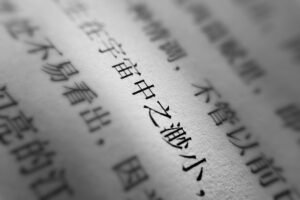The HSK (Hanyu Shuiping Kaoshi) Chinese Proficiency Test is an internationally recognized standardized test that assesses the Chinese language proficiency of non-native speakers. It was developed by the Hanban, an organization affiliated with the Chinese Ministry of Education, and was first introduced in 1984. The main purpose of the HSK test is to evaluate the Chinese language skills of individuals who are learning Chinese as a second language.
The HSK test is widely recognized and accepted by educational institutions and employers around the world as a measure of Chinese language proficiency. It is used for various purposes, such as admission to Chinese universities, job applications, and assessing language skills for immigration purposes. The test is divided into different levels, ranging from HSK 1 (beginner) to HSK 6 (advanced), with each level assessing different aspects of language proficiency, including listening, reading, writing, and speaking.
Table of Contents
ToggleKey Takeaways
- HSK is a Chinese proficiency test that measures the ability of non-native speakers to use Chinese in their daily lives.
- Other Chinese language tests include YCT, BCT, and C.TEST, which are designed for specific purposes and levels of proficiency.
- HSK is different from other Chinese language tests in terms of its focus on practical language skills and its standardized format.
- HSK test structure includes listening, reading, and writing sections, while other tests may have additional sections such as speaking or business Chinese.
- HSK test levels range from 1 to 6, with each level covering different vocabulary and grammar points, while other tests may have different level systems and content.
- HSK test scoring is based on a scale of 0-300, with different levels requiring different scores, while other tests may have different scoring systems and criteria.
- Benefits of taking the HSK test include improving language skills, enhancing job opportunities, and gaining recognition for language proficiency.
Overview of Other Chinese Language Tests
In addition to the HSK test, there are several other Chinese language tests that are used to assess language proficiency. These include the YCT (Youth Chinese Test), BCT (Business Chinese Test), and C.TEST (Chinese Test). Each test has its own purpose and target audience.
The YCT is designed for young learners of Chinese aged between 6 and 18 years old. It assesses their ability to use basic Chinese in daily life and school settings. The YCT is divided into four levels, with Level 1 being the easiest and Level 4 being the most difficult.
The BCT is designed for individuals who need to use Chinese in a business context. It assesses their ability to communicate effectively in business situations, such as meetings, negotiations, and presentations. The BCT is divided into three levels: BCT-A (Elementary), BCT-B (Intermediate), and BCT-C (Advanced).
The C.TEST is designed for individuals who need to use Chinese in academic settings. It assesses their ability to understand and use Chinese in academic contexts, such as reading academic texts, writing essays, and giving presentations. The C.TEST is divided into three levels: C.TEST-A (Elementary), C.TEST-B (Intermediate), and C.TEST-C (Advanced).
Differences between HSK and Other Chinese Language Tests
While the HSK test and other Chinese language tests share the same goal of assessing language proficiency, there are several differences between them in terms of test structure, content, and evaluation.
One major difference is the target audience of each test. The HSK test is designed for non-native speakers of Chinese who are learning the language as a second language. It assesses their overall language proficiency, including listening, reading, writing, and speaking skills. On the other hand, the YCT is specifically designed for young learners of Chinese, while the BCT and C.TEST are designed for individuals who need to use Chinese in business and academic contexts respectively.
Another difference is the test structure and format. The HSK test consists of multiple-choice questions that assess listening, reading, and writing skills. The speaking section of the test is conducted face-to-face with an examiner. In contrast, the YCT, BCT, and C.TEST have different formats depending on the level. For example, the YCT includes listening, reading, and writing sections, while the BCT includes listening, reading, writing, and speaking sections.
Furthermore, the content of each test also differs. The HSK test focuses on vocabulary, grammar, and reading comprehension skills at different levels. The YCT focuses on basic vocabulary and sentence patterns that are commonly used in daily life. The BCT focuses on business vocabulary and communication skills in a business context. The C.TEST focuses on academic vocabulary and skills required for academic reading, writing, and speaking.
HSK Test Structure and Format
| Section | Number of Questions | Duration | Skills Tested |
|---|---|---|---|
| Listening | 35 | Approximately 35 minutes | Listening comprehension |
| Reading | 25 | Approximately 40 minutes | Reading comprehension |
| Writing | Writing characters and sentences | Approximately 25 minutes | Writing ability |
| Speaking | 11-14 | Approximately 11-14 minutes | Oral proficiency |
The HSK test consists of six levels, ranging from HSK 1 (beginner) to HSK 6 (advanced). Each level assesses different aspects of language proficiency, including listening, reading, writing, and speaking.
The HSK test is divided into two parts: a written test and an oral test. The written test consists of listening, reading, and writing sections, while the oral test assesses speaking skills. The written test is conducted on a computer, while the oral test is conducted face-to-face with an examiner.
The listening section of the HSK test assesses the ability to understand spoken Chinese in various contexts. It includes multiple-choice questions that require candidates to listen to dialogues and monologues and answer questions based on what they hear.
The reading section assesses the ability to understand written Chinese. It includes multiple-choice questions that require candidates to read passages and answer questions based on the information provided.
The writing section assesses the ability to write Chinese characters and sentences. It includes tasks such as writing characters, completing sentences, and writing short essays.
The speaking section assesses the ability to communicate orally in Chinese. It includes tasks such as answering questions, describing pictures, and having a conversation with the examiner.
Other Chinese Language Test Structures and Formats
The YCT test consists of four levels, ranging from YCT 1 to YCT 4. Each level assesses different aspects of language proficiency, including listening, reading, and writing skills.
The YCT test is divided into three parts: a listening section, a reading section, and a writing section. The listening section assesses the ability to understand spoken Chinese in various contexts. It includes multiple-choice questions that require candidates to listen to dialogues and monologues and answer questions based on what they hear.
The reading section assesses the ability to understand written Chinese. It includes multiple-choice questions that require candidates to read passages and answer questions based on the information provided.
The writing section assesses the ability to write Chinese characters and sentences. It includes tasks such as writing characters, completing sentences, and writing short essays.
The BCT test consists of three levels: BCT-A, BCT-B, and BCT-C. Each level assesses different aspects of language proficiency, including listening, reading, writing, and speaking skills.
The BCT test is divided into four parts: a listening section, a reading section, a writing section, and a speaking section. The listening section assesses the ability to understand spoken Chinese in various business contexts. It includes multiple-choice questions that require candidates to listen to dialogues and monologues and answer questions based on what they hear.
The reading section assesses the ability to understand written Chinese in a business context. It includes multiple-choice questions that require candidates to read passages and answer questions based on the information provided.
The writing section assesses the ability to write Chinese characters and sentences in a business context. It includes tasks such as writing emails, memos, and reports.
The speaking section assesses the ability to communicate orally in Chinese in a business context. It includes tasks such as giving presentations, participating in meetings, and negotiating with others.
The C.TEST consists of three levels: C.TEST-A, C.TEST-B, and C.TEST-C. Each level assesses different aspects of language proficiency, including listening, reading, writing, and speaking skills.
The C.TEST is divided into four parts: a listening section, a reading section, a writing section, and a speaking section. The listening section assesses the ability to understand spoken Chinese in various academic contexts. It includes multiple-choice questions that require candidates to listen to lectures, discussions, and conversations and answer questions based on what they hear.
The reading section assesses the ability to understand written Chinese in an academic context. It includes multiple-choice questions that require candidates to read academic texts and answer questions based on the information provided.
The writing section assesses the ability to write Chinese characters and sentences in an academic context. It includes tasks such as writing essays, summaries, and reports.
The speaking section assesses the ability to communicate orally in Chinese in an academic context. It includes tasks such as giving presentations, participating in discussions, and expressing opinions on various topics.
HSK Test Levels and Content
The HSK test is divided into six levels, ranging from HSK 1 (beginner) to HSK 6 (advanced). Each level assesses different aspects of language proficiency, including vocabulary, grammar, and reading comprehension skills.
HSK 1 is the beginner level and assesses basic listening and reading skills. Candidates are expected to have a vocabulary of about 150 words and be able to understand simple sentences and short passages.
HSK 2 is the elementary level and assesses basic listening, reading, and writing skills. Candidates are expected to have a vocabulary of about 300 words and be able to understand simple conversations and short passages.
HSK 3 is the intermediate level and assesses listening, reading, and writing skills at a higher level. Candidates are expected to have a vocabulary of about 600 words and be able to understand longer conversations and passages.
HSK 4 is the upper-intermediate level and assesses listening, reading, and writing skills at a more advanced level. Candidates are expected to have a vocabulary of about 1,200 words and be able to understand more complex conversations and passages.
HSK 5 is the advanced level and assesses listening, reading, and writing skills at an advanced level. Candidates are expected to have a vocabulary of about 2,500 words and be able to understand authentic materials such as news articles and academic texts.
HSK 6 is the highest level and assesses listening, reading, and writing skills at a near-native level. Candidates are expected to have a vocabulary of about 5,000 words and be able to understand complex materials such as literature and academic papers.
Other Chinese Language Test Levels and Content
The YCT test is divided into four levels, ranging from YCT 1 to YCT 4. Each level assesses different aspects of language proficiency, including vocabulary, grammar, and reading comprehension skills.
YCT 1 is the beginner level and assesses basic listening, reading, and writing skills. Candidates are expected to have a vocabulary of about 150 words and be able to understand simple sentences and short passages.
YCT 2 is the elementary level and assesses basic listening, reading, and writing skills at a higher level. Candidates are expected to have a vocabulary of about 300 words and be able to understand simple conversations and short passages.
YCT 3 is the intermediate level and assesses listening, reading, and writing skills at a more advanced level. Candidates are expected to have a vocabulary of about 600 words and be able to understand longer conversations and passages.
YCT 4 is the advanced level and assesses listening, reading, and writing skills at an advanced level. Candidates are expected to have a vocabulary of about 1,200 words and be able to understand more complex conversations and passages.
The BCT test is divided into three levels: BCT-A, BCT-B, and BCT-C. Each level assesses different aspects of language proficiency, including vocabulary, grammar, and communication skills in a business context.
BCT-A is the elementary level and assesses basic listening, reading, writing, and speaking skills in a business context. Candidates are expected to have a vocabulary of about 600 words and be able to understand simple business conversations and passages.
BCT-B is the intermediate level and assesses listening, reading, writing, and speaking skills at a higher level in a business context. Candidates are expected to have a vocabulary of about 1,200 words and be able to understand more complex business conversations and passages.
BCT-C is the advanced level and assesses listening, reading, writing, and speaking skills at an advanced level in a business context. Candidates are expected to have a vocabulary of about 2,500 words and be able to understand authentic business materials such as reports and presentations.
The C.TEST is divided into three levels: C.TEST-A, C.TEST-B, and C.TEST-C. Each level assesses different aspects of language proficiency, including vocabulary, grammar, and academic skills.
C.TEST-A is the elementary level and assesses basic listening, reading, writing, and speaking skills in an academic context. Candidates are expected to have a vocabulary of about 600 words and be able to understand simple academic conversations and passages.
C.TEST-B is the intermediate level and assesses listening, reading, writing, and speaking skills at a higher level in an academic context. Candidates are expected to have a vocabulary of about 1,200 words and be able to understand more complex academic conversations and passages.
C.TEST-C is the advanced level and assesses listening, reading, writing, and speaking skills at an advanced level in an academic context. Candidates are expected to have a vocabulary of about 2,500 words and be able to understand authentic academic materials such as research papers and lectures.
HSK Test Scoring and Evaluation
The HSK test uses a scoring system that ranges from 0 to 300 points. Each section of the test (listening, reading, writing, speaking) is scored separately, and the scores are then combined to give an overall score.
The scoring system for the HSK test is as follows:
– 0-49 points: Fail
– 50-89 points: HSK 1
– 90-109 points: HSK 2
– 110-149 points: HSK 3
– 150-209 points: HSK 4
– 210-269 points: HSK 5
– 270-300 points: HSK 6
The evaluation criteria for the HSK test are based on the candidate’s ability to understand and use Chinese in various contexts. The criteria include vocabulary, grammar, reading comprehension, listening comprehension, and speaking skills.
Other Chinese Language Test Scoring and Evaluation
The scoring and evaluation system for other Chinese language tests such as the YCT, BCT, and C.TEST are similar to the HSK test. Each section of the test is scored separately, and the scores are then combined to give an overall score.
The scoring system for the YCT test is as follows:
– 0-49 points: Fail
– 50-89 points: YCT 1
– 90-109 points: YCT 2
– 110-149 points: YCT 3
– 150-200 points: YCT 4
The scoring system for the BCT test is as follows:
– 0-49 points: Fail
– 50-89 points: BCT-A
– 90-109 points: BCT-B
– 110-149 points: BCT-C
The scoring system for a game can vary depending on the specific rules and objectives of the game. In some games, points are awarded based on specific actions or achievements, such as scoring a goal in soccer or capturing an opponent’s piece in chess. Other games may use a more complex scoring system that takes into account multiple factors, such as time taken to complete a task or the quality of a performance. Additionally, some games may have a scoring system that is subjective, relying on judges or referees to assign points based on their assessment of the players’ performance. Ultimately, the scoring system is designed to determine a winner and provide a measure of success or achievement in the game.
Contact our head teacher, Chen Huimin, at info@lcchineseschool.com if you want to learn Chinese or have additional questions about our Chinese programs.
Sign up for a free trial class here.
Learn about our Internship Program in China.
Get free Chinese learning resources.
Learn about China’s 2024 Offical Holiday Schedule








